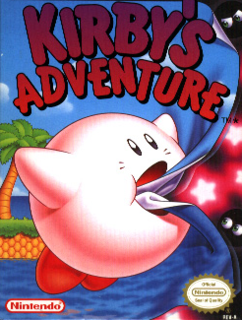If you're looking for a cutesy and accesible platforming romp, this is as a good place as ever to start.
The story begins on the peaceful planet of Pop Star, where the inhabitants are in unrest. King Dedede has stolen the Star Rod, broken it into seven pieces, and divided the parts among his followers. Without the Star Rod, the Fountain of Dreams is powerless and the people of Dream Land can no longer have good dreams, now suffering from insomnia. Kirby, the ever-valiant pink puffball, sets out on a quest to reclaim the Star Rod. Of course, most stories are never that simple; there's more than meets the eye to Dedede's nefarious ploy...
Nightmare in Dream Land is (more or less) a traditional platformer; your main goal is to make it to the end of level. Kirby's skillset is simple; he can walk, run, slide, jump, float through the air indefinitely, and inhale most items/adversaries that he comes across. Should Kirby inhale and swallow certain foes, he'll copy their abilities to use as his own. While most of these abilities are strictly combat-only, others possess optional uses that are useful for completing certain puzzles (for example, "Fire" can be used to light matches connected to cannons, which in turn, blast Kirby into new/hidden sections of the levels).
More in line with games like Zelda or Metroid, Kirby possess a health meter (with a maximum value of six). Should Kirby sustain damage six times, our poor little puffball will lose a life. Should he lose all of his lives... well, you know the drill. Luckily for Kirby, there are plenty of restorative items, 1-ups, and invincibility powerups scattered along the levels to help you out.
Whereas most platformers prohibit (or severely limit) backtracking, Nightmare in Dreamland has a pseudo-hub structure; as you progress through the levels, areas on each "floor" will open up, not only granting access to areas you've already completed, but other areas (such as arenas and minigames) as well. Upon defeating a boss, a passageway to the set of levels is opened, granting you unrestricted travel to and fro each level.
In addition, Nightmare in Dream Land contains a few (but much appreciated) bonus modes and minigames. While most of the minigames are mindless (albeit fun) distractions, the additional gameplay modes are amazing. The first is an extra mode; here, Kirby's life meter is reduced by half, ramping up the otherwise easy difficulty a few notches. Should you fully best this challenge, "Meta Knightmare" opens up. Here, you are in control of Meta Knight, Kirby's enigmatic rival. While Meta Knight's adventure is merely a retread of Kirby's, you can't deny that playing as a caped warrior with a golden sword is cool.
As said above, Kirby is probably one of the easier platforming series in existence. Any "real" challenges won't present themselves until late in the game, and even these so-called trials will be a cakewalk to seasoned veterans. Then again, I wouldn't have Kirby any other way.
The light-hearted and pleasant music from Kirby's Adventure has been remixed and enhanced. Listening to the soundtrack will usually make you feel as if you're on cloud nine.
The graphics have received a similar overhaul (i.e. you'll see that Kirby's inhale motion is similar to that of the anime, Kirby Right Back at Ya!). My only criticism is that some of the more graphically impressive features from the original (such as parallax scrolling) were left out for no apparent reason. Seems a bit lazy, eh?
Challenge or not, there is fun to be had with this Kirby. And when all comes down to it, shouldn't that be the main factor in buying a game?

